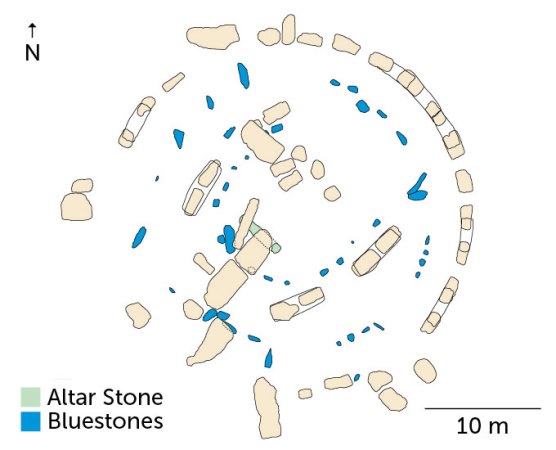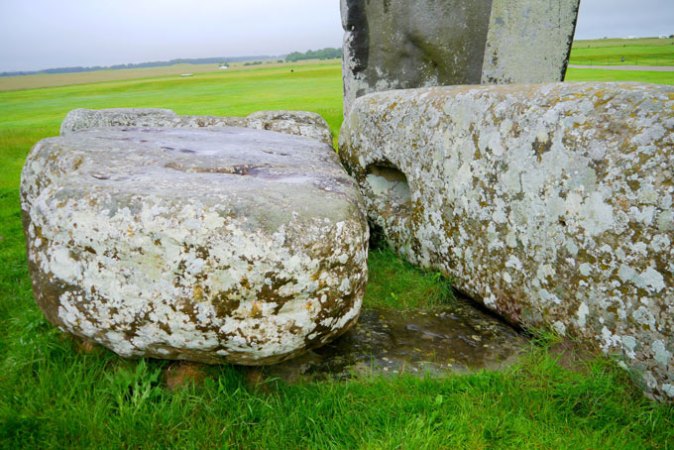Stonehenge had a hard Scottish heart, a new study suggests.
The ancient site’s central stone, a large slab known as the Altar Stone, consists of rock transported at least 750 kilometers from northeastern Scotland to southern England, say geoscientist Anthony Clarke of Curtin University in Perth, Australia, and colleagues.
An analysis of the age and chemical makeup of three types of mineral grains in two Altar Stone fragments identified a close match to corresponding measures for a Scottish rock formation known as the Orcadian Basin, the researchers report August 14 in Nature. Using the same measures, they ruled out other rock formations in the United Kingdom and Ireland as sources for the Altar Stone.
The sandstone slab sits within a semicircular arc of smaller stones, known as bluestones. Most of the bluestones have been chemically traced to a rock source in western Wales, around 225 kilometers west of Stonehenge. A more than 5,000-year-old Welsh stone circle may have provided initial building blocks for Stonehenge (SN: 2/11/21).
The new study challenges a previous assumption that the Altar Stone, due to its position near the bluestone arc, also had Welsh roots.
A combination of estimated ages for the three minerals in the Altar Stone — which ranged from several hundred million to 3 billion years old — provided a gauge for identifying which existing rock source represented the most likely source for the Stonehenge stone. Decay of small amounts of radioactive elements in crystallized minerals — such as the breakdown of uranium into lead in zircon crystals — occurs at known rates, which enabled Clarke’s team to calculate the age estimates.
Moving a massive stone to Stonehenge
Transporting the six-metric-ton Altar Stone from Scotland to southern England’s Salisbury Plain would have presented a daunting challenge.
Altar Stone transport may have depended on the precise location it came from, which has yet to be established, geochemist Nick Pearce of Aberystwyth University in Wales said at an August 13 news conference. The Orcadian Basin extends from northeastern Scotland to the Orkney Islands off Scotland’s northern coast. Transport by ship down England’s east coast before lugging the Altar Stone about 160 kilometers to Stonehenge from the English Channel, rather than a strictly overland route, makes more sense if the Altar Stone came from an island, Pearce said.
Researchers do not know when the Altar Stone arrived at Stonehenge. Construction began around 5,000 years ago (SN: 5/29/08). Initially serving as a cemetery, changes and additions to the site occurred over the next two millennia.
The sandstone slab may have been placed among the bluestones during a second construction phase between 2620 B.C. and 2150 B.C., the researchers suspect.

A Scottish source for the Altar Stone adds to evidence that increasingly points to long-distance connections, including shared pottery styles and house plans, among Late Neolithic groups that inhabited the British Isles during Stonehenge’s construction phases, says archaeologist Alasdair Whittle of Cardiff University in Wales. Diet-related chemical signatures in excavated bones have suggested that some Late Neolithic domestic animals in southern England came from the north, possibly Scotland, says Whittle, who did not participate in the new study.
“This was an age of heroic feats of shared labor, movement and assembly, into which an Altar Stone from northeastern Scotland would perfectly well fit in,” Whittle says.
The mystery of the Altar Stone’s orientation at Stonehenge
A Scottish origin for the Altar Stone also highlights an intriguing architectural link, says archaeologist Joshua Pollard of the University of Southampton in England. Unlike other stones at Stonehenge, the Altar Stone lies on its side — a detail seen in some stone circles in Scotland.
Two collapsed stones from the monument’s outer circle rest atop the Altar Stone, which is broken in two and has largely sunk into the grass. In contrast to the Altar Stone’s distant origins, those massive outer-circle stones came from a rock source located 25 kilometers north of Stonehenge.

Researchers do not know whether the Altar Stone originally stood upright.
A region of Scotland called Aberdeenshire contains up to 99 recorded examples of Recumbent Stone Circles. In each case, a ring of standing stones surrounds a slab laid on its side in the ring’s southwestern or southern arc.
Aberdeenshire’s Recumbent Stone Circles represent “a very interesting architectural connection [to the Altar Stone],” says Pollard, who was not part of Clarke’s team.
#Stonehenges #mysterious #Altar #Stone #roots #Scotland
Image Source : www.sciencenews.org